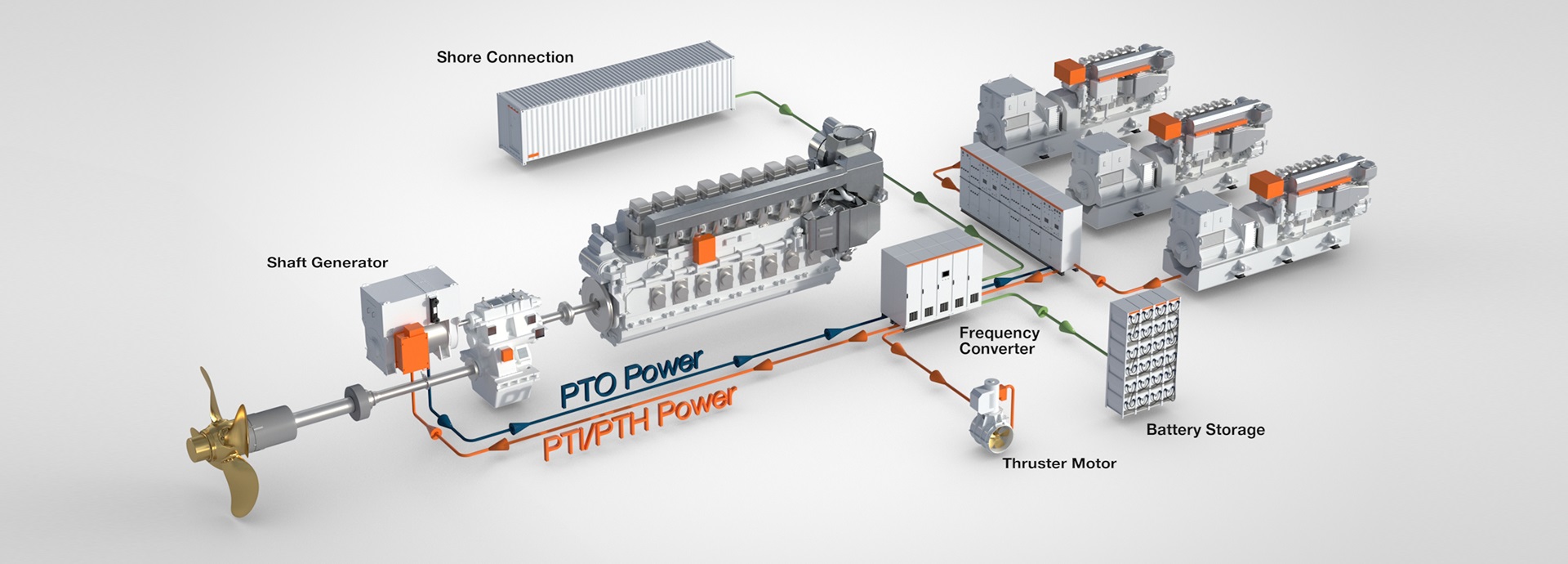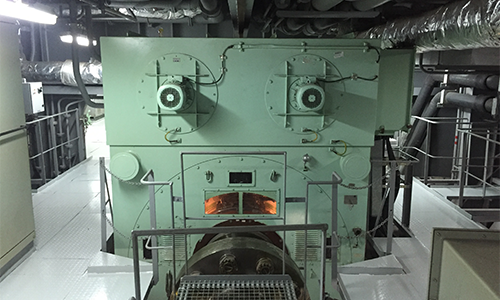

The ferry segment has been one of the leading lights on the journey towards eco-efficient hybrid and fully electric vessel operations. Integrating a hybrid shaft generator system with onboard energy storage on a large RoRo or RoPax vessel delivers optimised engine load and the opportunity to generate electrical power from the main engine instead of from auxiliaries. With significantly reduced fuel consumption, maintenance requirements and emissions, this approach seems like a logical choice – but what does it involve?
Ferry operators, like operators in every other maritime segment, are under pressure to improve efficiency, reduce operating costs and decarbonise in order comply with tightening emissions legislation. Compared to other vessel types, however, ferries – with their higher hotel load, significant time spent in and around harbours, and tourist-facing operations – are especially well placed to benefit from hybrid shaft generator systems.
In ferry operations auxiliary engines are traditionally used to power the thrusters needed to manoeuvre in the harbour. They are also used to supply the hotel load – the power needed to operate systems other than propulsion, such as climate control, lighting and refrigeration systems. With an optimised hybrid system both these needs can be covered by batteries alone. This provides a significant advantage during port calls and when entering or leaving harbour and/or sailing in slow transit areas, where emissions and noise need to be kept below specified limits.
Hybrid shaft generator systems contribute to decarbonisation by helping to greatly reduce, and in some cases even eliminate, the need for auxiliary engines and their associated emissions; they also contribute to reduced fuel costs and maintenance requirements. “Energy storage decouples energy production from consumption, meaning that energy-producing assets onboard can operate at maximum efficiency, providing instant power as needed and improving redundancy, load response and power availability,” says Michael Kranz, General Manager, Shaft Generator Systems, Wärtsilä.
Turn engines into an electrical power source
“When integrating battery energy storage onboard, rather than starting up auxiliary engines purely to charge the batteries it is far more efficient to use a shaft generator system,” Kranz continues. “Shaft generators, which are driven by the main engine, supply power at a constant voltage and frequency even if the vessel speed changes or the propeller speed varies as a result of the sea conditions.”
A shaft generator uses the main engine and propeller shaft’s rotational motion to generate electricity, with a frequency converter supplying three-phase current at a constant voltage to engines and thrusters, and to cover the hotel load.
“Incorporating a shaft generator in a hybrid system enables a significant reduction in fuel consumption, emissions and maintenance costs, and also reduces noise levels associated with power generation. Furthermore, the payback time can be short, perhaps two to four years depending on the system power capacity,” explains Christian Heinsohn, General Manager Sales & Sales Support, Electrical & Power Management Systems, Wärtsilä.
Wärtsilä has over 60 years of experience delivering shaft generator systems and has installed more than 550 such systems, including around 40 hybrid systems, on ships all around the world, allowing owners and operators alike to reap significant operational benefits.

“With our smart EMS, ships in the harbour can now operate on battery storage alone and react within milliseconds without the use of auxiliary and redundant engines for safety.
Give the auxiliary engines a break
Large ferries, especially RoPax vessels, employ powerful thrusters to provide the high levels of manoeuvrability they often need in harbours. “Traditionally these are powered by dedicated auxiliary engines that are only used for a few minutes a day. This is low-hanging fruit for a hybrid system, as the battery is charged by the shaft generator during the voyage and then discharges energy to the thrusters for use in port. The result is quieter operation, reduced visible smoke emissions and no need to power up auxiliary gensets in harbours,” highlights Kranz.
Depending on the size of the vessel and the length of stay in the harbour, the batteries can handle the full hotel load, meaning less energy needs to be consumed via the onshore connection and auxiliary engine operation can be further reduced.
The smartest way to join the dots
With hybrid setups, smart integration of the various components is the key to success. As part of its hybrid power module for ship propulsion, Wärtsilä has developed a highly sophisticated and fully integrated energy management system (EMS). This acts as the ‘brain’ controlling the energy flows between the different power producers and consumers.
“With our smart EMS, ships in the harbour can now operate on battery storage alone and react within milliseconds without the use of auxiliary and redundant engines for safety. A hybrid system is only as good as the software at its core, and this is where our EMS adds a great deal of value, especially when we consider the possible future need to integrate other energy generation sources. These could include solar panels, wind turbines and fuel cells,” explains Kranz.
A single integrator reduces the headaches for everyone
Wärtsilä’s holistic approach uses data-driven design to develop an energy optimised and future-proof system for large ferries that delivers significantly higher value than the sum of its parts – engines, propulsion systems, energy storage hardware and software, and the EMS and interfaces that tie everything together.
“We can act as the lead integrator, providing the topology, design and interfaces for the entire hybrid system. Rather than buying the battery, switchboard and thrusters from three different suppliers and spending time trying to integrate them all, the shipyard can focus on putting everything together – and can rest assured that all the parts have been designed to work together optimally out of the box. We are well aware of the challenges faced in integrating power control and management systems with shaft generators and energy storage systems. Thanks to our global presence – including Electrical Power Management System resources in China, Korea, the US and Europe – we can respond quickly to requests from vessel owners and shipyards wherever they are located and put together a working proposal within a relatively short timeframe,” says Heinsohn.
Optimised long-term performance
To ensure that owners and operators gain maximum value from their carefully optimised integrated system throughout the lifecycle of the vessel, Wärtsilä offers a range of tailored Lifecycle Service agreements. These are available
with varying levels of support depending on the customer’s needs, but all are based on solid, actionable data.
“The EMS generates a lot of valuable data that we can leverage to optimise vessel performance and extend
maintenance intervals. With a service like Wärtsilä Expert Insight we can use this data to proactively identify early indications of equipment deterioration and inefficient operation, for example, and provide actionable recommendations
to resolve these issues and support efforts towards decarbonisation,” Heinsohn explains.



